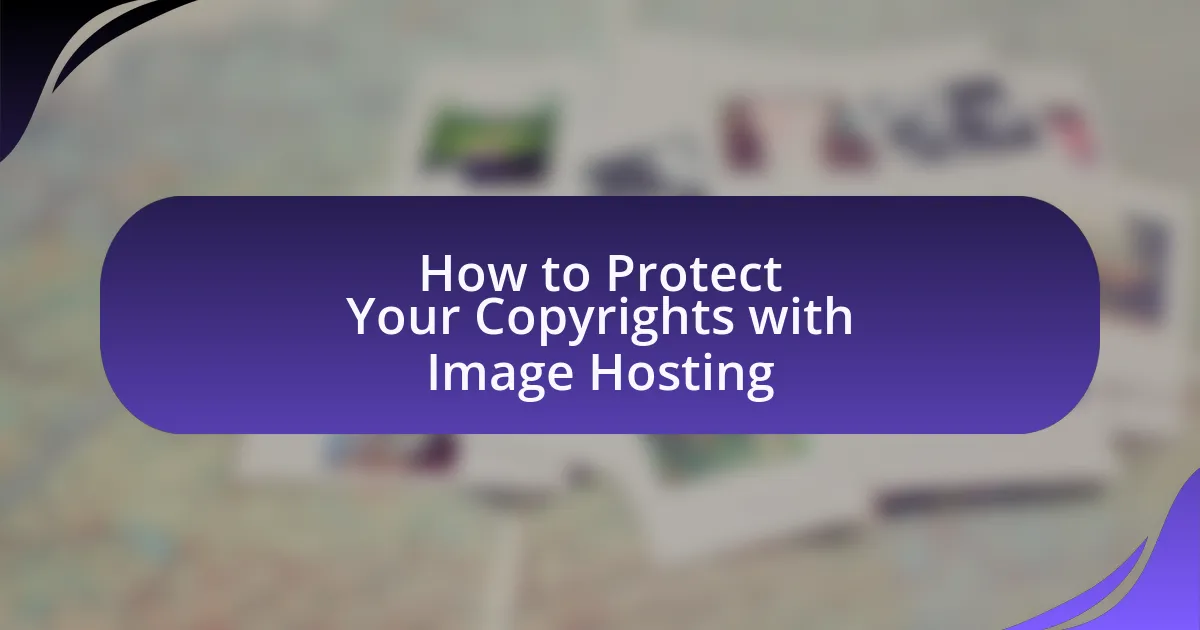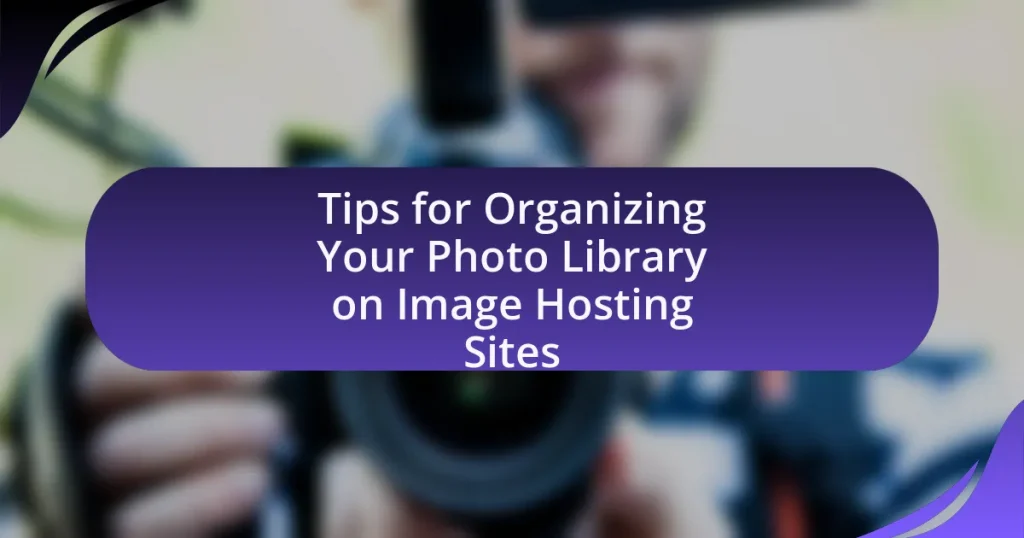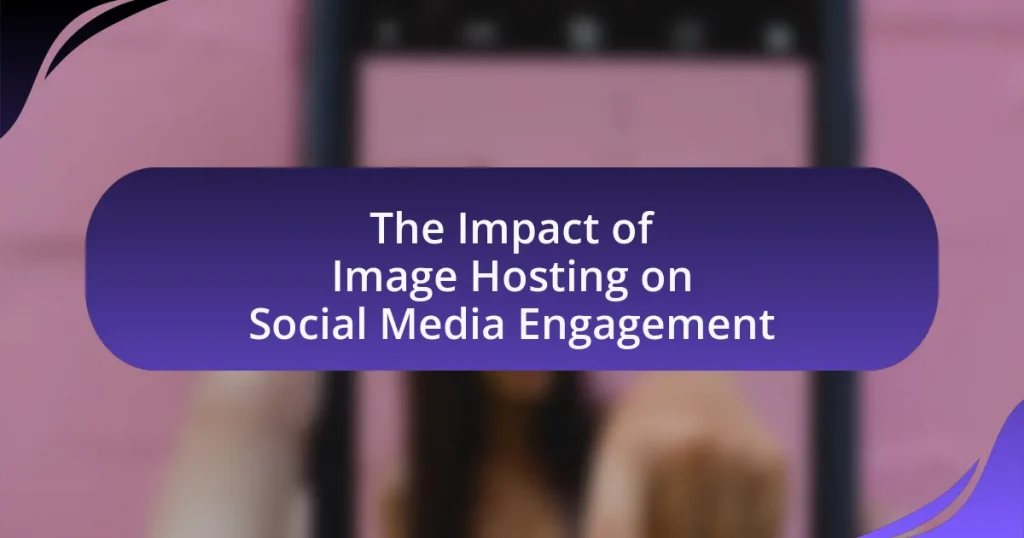Copyright protection in image hosting is a critical legal framework that safeguards the rights of creators over their original images uploaded to online platforms. This article outlines the importance of copyright protection, detailing how it applies to images hosted online, the legal frameworks governing these rights, and the risks creators face without such protection. It also discusses the role of image hosting services in enforcing copyright policies, best practices for creators to protect their work, and the significance of features like watermarking and metadata. Additionally, the article highlights common mistakes to avoid and the implications of improper licensing in the context of copyright enforcement.
What is Copyright Protection in Image Hosting?
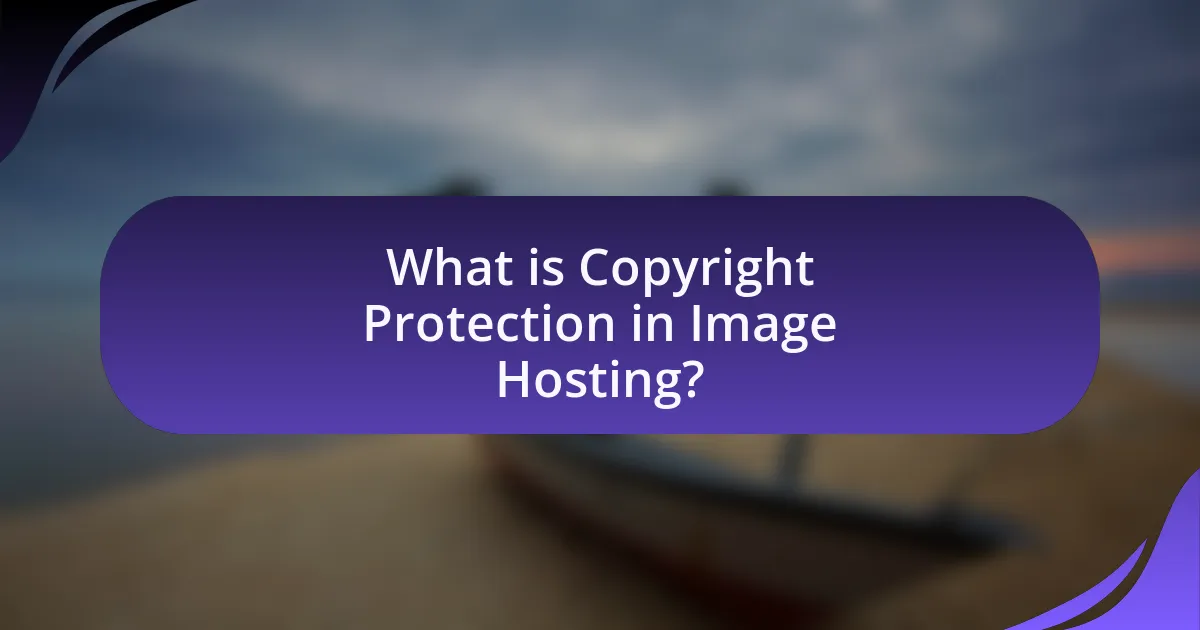
Copyright protection in image hosting refers to the legal rights that creators have over their original images when they are uploaded to online platforms. This protection ensures that the creator retains control over the use, distribution, and reproduction of their images, preventing unauthorized use by others. Under copyright law, images are automatically protected upon creation, meaning that the creator does not need to register the image to have rights over it. This legal framework is supported by international treaties, such as the Berne Convention, which establishes that copyright protection is granted to works without formal registration, thereby reinforcing the creator’s rights in image hosting environments.
How does copyright protection apply to images hosted online?
Copyright protection applies to images hosted online by granting the creator exclusive rights to use, distribute, and reproduce their work. Under the Copyright Act, images are automatically protected upon creation, meaning that the original creator retains rights regardless of whether the image is registered with a copyright office. This protection extends to digital formats, and unauthorized use of these images can lead to legal consequences, including statutory damages. Additionally, the Digital Millennium Copyright Act (DMCA) provides a framework for copyright holders to request the removal of infringing content from online platforms, reinforcing the legal standing of copyright in the digital space.
What are the legal frameworks governing copyright for images?
The legal frameworks governing copyright for images primarily include national copyright laws, international treaties, and specific regulations regarding digital content. In the United States, the Copyright Act of 1976 provides the foundational legal structure, granting creators exclusive rights to reproduce, distribute, and display their works. Internationally, the Berne Convention for the Protection of Literary and Artistic Works establishes minimum standards for copyright protection, ensuring that images created in one member country receive protection in others. Additionally, the Digital Millennium Copyright Act (DMCA) addresses copyright issues in the digital environment, providing mechanisms for copyright holders to protect their images online. These frameworks collectively ensure that creators maintain control over their visual works and can seek legal recourse against unauthorized use.
How do copyright laws differ across countries for image hosting?
Copyright laws for image hosting vary significantly across countries, primarily due to differences in legal frameworks, enforcement mechanisms, and cultural attitudes towards intellectual property. For instance, the United States operates under the Copyright Act of 1976, which emphasizes the protection of original works and allows for fair use, while the European Union follows the Copyright Directive, which includes stricter regulations on copyright infringement and stronger protections for authors. Additionally, countries like Japan have unique provisions that address moral rights, granting creators the right to object to derogatory treatment of their works. These variations can affect how image hosting platforms operate, the liability they face for user-uploaded content, and the rights of creators in different jurisdictions.
Why is copyright protection important for image creators?
Copyright protection is crucial for image creators because it grants them exclusive rights to their original works, allowing them to control how their images are used and distributed. This legal framework helps prevent unauthorized reproduction and exploitation of their creations, ensuring that creators can monetize their work and receive recognition for their contributions. According to the U.S. Copyright Office, copyright protection automatically applies to original works of authorship, including images, as soon as they are fixed in a tangible medium, reinforcing the importance of copyright in safeguarding the interests of image creators.
What risks do image creators face without copyright protection?
Image creators face significant risks without copyright protection, including unauthorized use of their work, loss of potential income, and diminished control over how their images are used. Without copyright, others can freely reproduce, distribute, or modify the images without permission, leading to potential exploitation. This lack of protection can result in financial losses, as creators may miss out on licensing fees or sales opportunities. Furthermore, the absence of copyright diminishes the creator’s ability to enforce their rights, making it challenging to address misuse or infringement effectively.
How does copyright protection enhance the value of images?
Copyright protection enhances the value of images by granting exclusive rights to creators, which prevents unauthorized use and exploitation. This exclusivity allows creators to monetize their work effectively, as they can license or sell their images without the risk of infringement. According to the U.S. Copyright Office, copyright protection not only safeguards the creator’s interests but also encourages investment in creative endeavors, leading to a more vibrant market for images. Consequently, images with copyright protection are often perceived as more valuable due to their legal backing and the assurance of originality.
How Can Image Hosting Services Help Protect Copyrights?

Image hosting services can help protect copyrights by providing secure storage and controlled access to images. These platforms often include features such as watermarking, which deters unauthorized use, and metadata embedding, which allows creators to retain ownership information. Additionally, many image hosting services offer tools for tracking image usage across the web, enabling copyright holders to monitor potential infringements. According to a study by the International Intellectual Property Alliance, effective use of digital tools, including image hosting services, significantly reduces instances of copyright infringement.
What features should you look for in an image hosting service for copyright protection?
An image hosting service for copyright protection should include features such as watermarking, metadata embedding, and access control. Watermarking allows users to overlay their images with identifying marks, deterring unauthorized use. Metadata embedding enables the inclusion of copyright information directly within the image file, making it easier to assert ownership. Access control features, such as password protection and restricted sharing options, help limit who can view or download the images, further safeguarding the owner’s rights. These features collectively enhance the protection of copyrighted images against infringement.
How do watermarking and metadata contribute to copyright protection?
Watermarking and metadata significantly enhance copyright protection by providing clear identification of ownership and usage rights. Watermarking embeds visible or invisible marks within images, making it difficult for unauthorized users to claim ownership or use the content without permission. This visual cue serves as a deterrent against theft and misuse. Metadata, on the other hand, contains embedded information about the creator, copyright status, and usage rights, which can be read by software and search engines. This data helps in tracking the distribution of images and asserting ownership in legal contexts. Together, these tools create a robust framework for protecting intellectual property, as evidenced by studies showing that watermarked images are less likely to be used without authorization compared to unmarked images.
What role does user access control play in protecting images?
User access control plays a critical role in protecting images by regulating who can view, modify, or share the images. This mechanism ensures that only authorized users have access to sensitive or copyrighted images, thereby reducing the risk of unauthorized use or distribution. For instance, platforms that implement robust user access controls can restrict image access based on user roles, ensuring that only specific individuals or groups can interact with the images. This is particularly important in copyright protection, as unauthorized access can lead to infringement and loss of intellectual property rights.
How do image hosting services enforce copyright policies?
Image hosting services enforce copyright policies primarily through the implementation of Digital Millennium Copyright Act (DMCA) takedown procedures. These services typically provide a mechanism for copyright holders to report unauthorized use of their images, which initiates a review process. Upon receiving a valid DMCA notice, the service is legally obligated to remove or disable access to the infringing content to avoid liability. This process is supported by the requirement for users to agree to terms of service that prohibit copyright infringement, thereby establishing a legal framework for enforcement. Additionally, many image hosting platforms utilize automated systems to detect and flag potentially infringing content, further strengthening their copyright enforcement efforts.
What are the common copyright infringement policies of image hosting platforms?
Image hosting platforms commonly implement policies that address copyright infringement by requiring users to adhere to copyright laws, providing mechanisms for reporting violations, and enforcing takedown procedures. These platforms typically include terms of service that explicitly state that users must own the rights to the images they upload or have permission from the copyright holder.
Additionally, many platforms follow the Digital Millennium Copyright Act (DMCA), which allows copyright owners to submit a notice for infringing content, prompting the platform to remove the content promptly. This process is designed to protect both the rights of the copyright holders and the platforms from liability. Furthermore, repeated violations can lead to account suspension or termination, reinforcing the importance of compliance with copyright regulations.
How can users report copyright violations on these platforms?
Users can report copyright violations on image hosting platforms by submitting a formal complaint through the platform’s designated reporting mechanism. Most platforms provide a specific form or email address for users to detail the infringement, including information about the copyrighted work and the unauthorized use. For example, platforms like Flickr and Instagram have clear guidelines and processes outlined in their help sections, allowing users to submit their claims efficiently.
What Best Practices Should You Follow for Copyright Protection with Image Hosting?
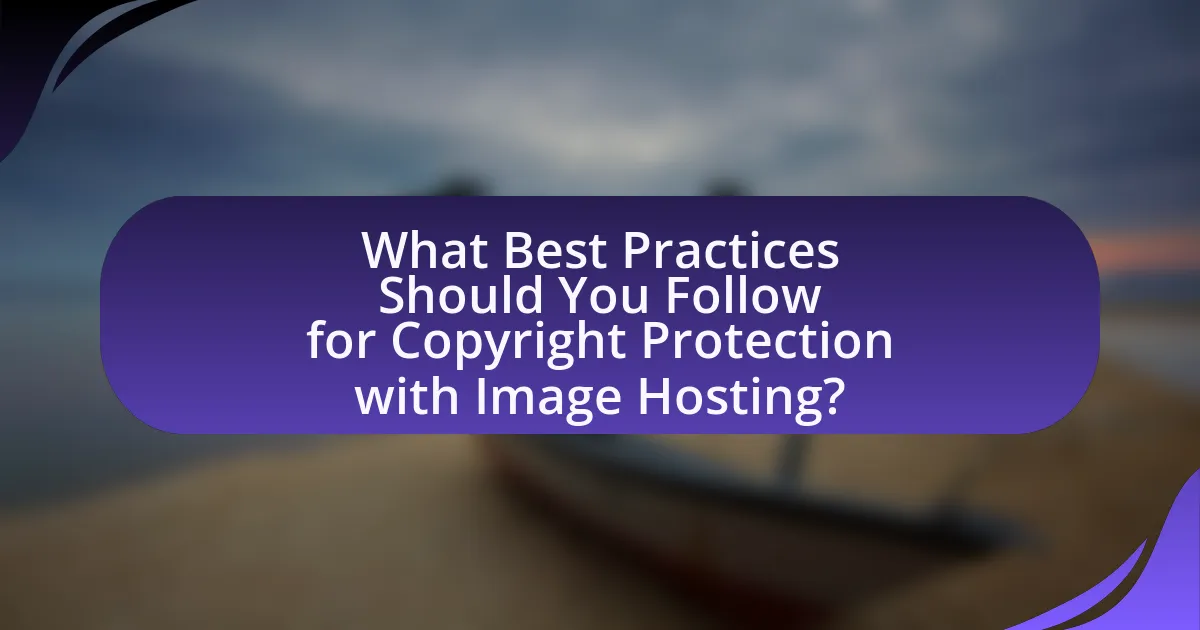
To protect copyrights with image hosting, you should implement several best practices. First, always watermark your images to deter unauthorized use and to establish ownership. Watermarks serve as a visual reminder of copyright and can reduce the likelihood of theft. Second, utilize metadata to embed copyright information directly into the image file, which can help in proving ownership if disputes arise. Third, choose a reputable image hosting service that offers copyright protection features, such as the ability to disable right-click downloads or to track image usage. Additionally, consider registering your images with a copyright office, as this provides legal advantages in case of infringement. According to the U.S. Copyright Office, registration is a prerequisite for filing a lawsuit for infringement, reinforcing the importance of this step. Lastly, monitor the internet for unauthorized use of your images using reverse image search tools, allowing you to take action if your work is misused.
How can you effectively use watermarks to protect your images?
To effectively use watermarks to protect your images, incorporate a semi-transparent logo or text overlay on your images. This method deters unauthorized use while maintaining the visual appeal of the image. Research indicates that images with watermarks are less likely to be used without permission, as they signal ownership and discourage theft. A study by the International Journal of Information Management found that visible watermarks significantly reduce the likelihood of image misuse, reinforcing the importance of this protective measure.
What are the best techniques for creating effective watermarks?
The best techniques for creating effective watermarks include using transparency, strategic placement, and incorporating text or logos. Transparency allows the watermark to blend with the image while remaining visible, ensuring it does not distract from the content. Strategic placement, such as positioning the watermark in a corner or across the center, helps deter unauthorized use without obstructing key visual elements. Incorporating text or logos that are distinctive and relevant to the owner enhances brand recognition and copyright protection. Research indicates that watermarks that are subtle yet identifiable significantly reduce the likelihood of image theft, as they serve as a deterrent while maintaining the aesthetic quality of the image.
How can watermarks impact the viewer’s experience?
Watermarks can significantly impact the viewer’s experience by altering their perception of the image and potentially distracting them from its content. When a watermark is prominently displayed, it can draw attention away from the visual elements, leading to a diminished appreciation of the artwork or photograph. Research indicates that viewers often find watermarked images less aesthetically pleasing, which can affect their overall engagement and emotional response to the content. For instance, a study published in the Journal of Visual Communication found that images with intrusive watermarks received lower ratings for visual appeal compared to unmarked images. This suggests that while watermarks serve a protective function for copyright, they can also hinder the viewer’s enjoyment and connection to the visual material.
What steps can you take to monitor and enforce your copyright online?
To monitor and enforce your copyright online, you can utilize digital tools and services designed for copyright protection. Employing services like Google Alerts allows you to track unauthorized use of your images by setting up alerts for specific keywords related to your work. Additionally, using reverse image search tools, such as TinEye or Google Images, helps identify where your images are being used across the web.
Furthermore, registering your copyright with the U.S. Copyright Office provides legal advantages, including the ability to sue for statutory damages and attorney fees in case of infringement. Implementing a watermark on your images can deter unauthorized use and make it easier to prove ownership.
Lastly, if you discover copyright infringement, sending a Digital Millennium Copyright Act (DMCA) takedown notice to the offending website can effectively remove your content from unauthorized use. These steps collectively enhance your ability to monitor and enforce your copyright online.
How can reverse image search tools assist in copyright enforcement?
Reverse image search tools assist in copyright enforcement by enabling creators to identify unauthorized use of their images across the internet. These tools analyze images and provide links to websites where similar or identical images appear, allowing copyright holders to track down instances of infringement. For example, a study by the University of California found that 80% of photographers reported discovering unauthorized use of their work through reverse image searches, highlighting the effectiveness of these tools in protecting intellectual property.
What are the benefits of using digital rights management (DRM) tools?
Digital rights management (DRM) tools provide several benefits, primarily by protecting intellectual property and ensuring that content creators maintain control over their work. DRM tools prevent unauthorized copying, distribution, and access to digital content, which helps to safeguard revenue streams for creators and publishers. For instance, a study by the International Intellectual Property Alliance indicates that effective DRM can reduce piracy rates by up to 30%, thereby enhancing the financial viability of creative industries. Additionally, DRM tools can facilitate compliance with licensing agreements, ensuring that users adhere to the terms set by content owners. This not only protects the rights of creators but also fosters a fair marketplace for digital content.
What are some common mistakes to avoid in copyright protection with image hosting?
Common mistakes to avoid in copyright protection with image hosting include failing to watermark images, neglecting to register copyrights, and not using proper licensing agreements. Watermarking images helps deter unauthorized use, while copyright registration provides legal evidence of ownership, making it easier to enforce rights. Additionally, using clear licensing agreements specifies how others can use the images, reducing the risk of infringement. These practices are essential for safeguarding intellectual property in the digital landscape.
How can improper licensing affect your copyright claims?
Improper licensing can significantly undermine your copyright claims by creating ambiguity regarding ownership and usage rights. When licensing agreements are not clearly defined or are incorrectly executed, it can lead to disputes over who holds the rights to the work, potentially allowing unauthorized use by others. For instance, if an image is licensed without proper attribution or outside the agreed terms, the original creator may find it challenging to enforce their copyright, as the misuse could be argued as a result of the unclear licensing terms. This situation is supported by legal precedents where courts have ruled in favor of defendants due to insufficient licensing documentation, highlighting the importance of precise and accurate licensing in protecting copyright claims.
What pitfalls should you be aware of when using free image hosting services?
When using free image hosting services, you should be aware of potential copyright issues, lack of control over your images, and the risk of service discontinuation. Copyright issues arise because many free services may claim ownership or usage rights over the images uploaded, which can lead to unauthorized use of your work. Additionally, users often have limited control over how their images are displayed or shared, making it difficult to manage their online presence. Furthermore, free services can shut down without notice, resulting in the loss of your images and any associated links or traffic. These factors highlight the importance of carefully reviewing the terms of service and considering alternative hosting options that provide better copyright protection and control.
